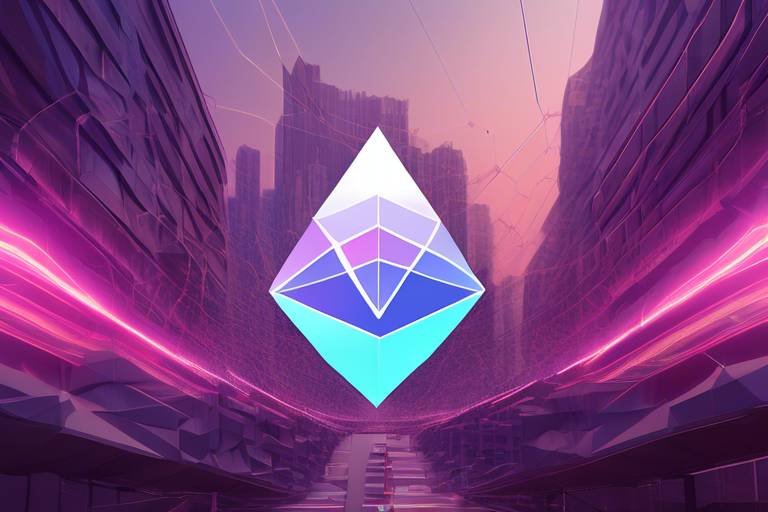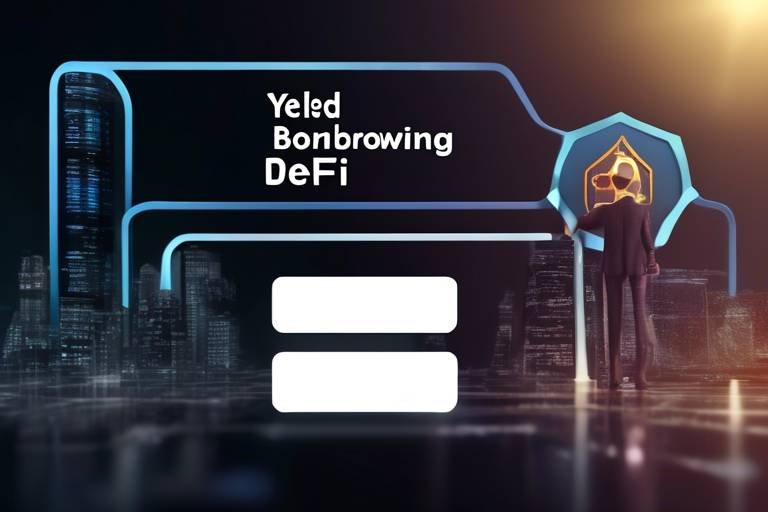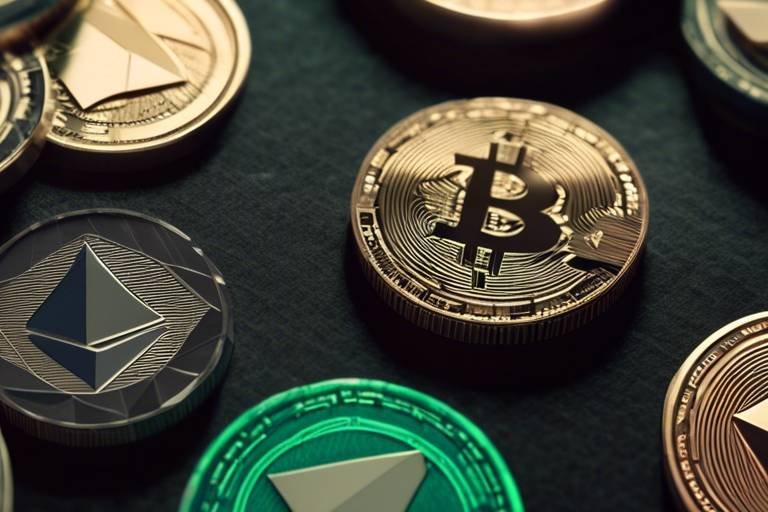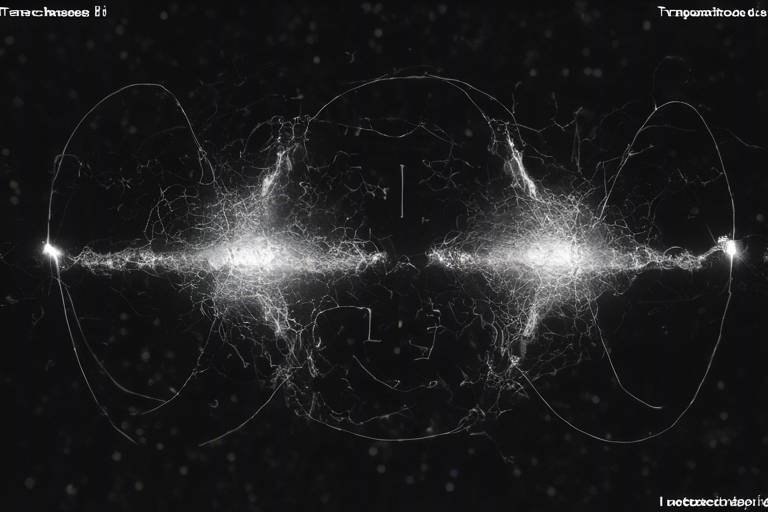Polygon (MATIC) - The Future of Ethereum Scaling
As the world of blockchain technology continues to evolve, one name that frequently pops up is Polygon (formerly known as Matic Network). This innovative platform is at the forefront of addressing one of the most pressing issues facing the Ethereum network today: scalability. With Ethereum often bogged down by high transaction fees and slow processing times, Polygon emerges as a beacon of hope, offering solutions that promise to enhance the overall user experience. But what exactly does Polygon bring to the table, and why should you care? Let's dive into the intricacies of this Layer 2 scaling solution and explore its potential impact on the blockchain ecosystem.
Polygon operates by leveraging a unique architecture that integrates multiple scaling solutions, allowing developers to build and deploy decentralized applications (dApps) that can operate more efficiently than ever before. Imagine trying to get a coffee during the morning rush at your favorite café. You could either wait in a long line (the Ethereum mainnet) or use a special express lane that Polygon provides, allowing you to grab your drink and get on with your day. This analogy perfectly encapsulates the benefits that Polygon offers: speed, efficiency, and cost-effectiveness.
But the question remains, what are the specific benefits that Polygon brings to developers and users alike? For starters, transaction speeds on Polygon can be significantly faster than those on the Ethereum mainnet. This is particularly crucial for applications that require real-time interactions, such as gaming and finance. In fact, users can expect near-instant transaction confirmations, making the experience seamless and enjoyable.
Moreover, Polygon's cost-effectiveness cannot be overstated. By drastically reducing transaction fees, it opens the floodgates for more developers to create dApps without worrying about exorbitant costs. This economic viability is a game-changer, fostering innovation and encouraging a diverse range of projects to flourish on the platform.
As we look ahead, it’s clear that Polygon is not just another scaling solution; it’s a comprehensive platform that empowers developers with robust tools and resources. The support provided by Polygon enables the creation and deployment of decentralized applications to be more efficient and effective. In essence, it’s like giving developers a well-equipped toolbox to build the next big thing in the blockchain space.
In conclusion, Polygon is paving the way for the future of Ethereum scaling. Its unique architecture, combined with its numerous benefits, positions it as a formidable player in the blockchain ecosystem. As we continue to explore its real-world applications and the challenges it may face, one thing is certain: Polygon is here to stay, and it’s set to redefine how we think about blockchain scalability.
- What is Polygon? Polygon is a Layer 2 scaling solution for Ethereum that aims to improve transaction speeds and reduce costs.
- How does Polygon enhance Ethereum's scalability? By utilizing various Layer 2 solutions, Polygon allows for faster and cheaper transactions compared to the Ethereum mainnet.
- What are the benefits of using Polygon? Benefits include lower fees, faster transaction times, and a developer-friendly environment.
- Is Polygon secure? While Polygon has security measures in place, continuous enhancements are needed to address potential vulnerabilities.
- What industries are adopting Polygon? Polygon is being used across various industries, including gaming, finance, and decentralized finance (DeFi).

Understanding Polygon's Architecture
Polygon's architecture is a game-changer in the world of blockchain technology, specifically designed to enhance the scalability of Ethereum. Imagine Ethereum as a bustling city, with countless transactions happening every second. Now, picture Polygon as a well-planned transportation system that alleviates traffic jams, ensuring that everyone gets to their destination faster and more efficiently. This is exactly what Polygon does by utilizing Layer 2 solutions to improve transaction speeds and reduce costs.
At its core, Polygon operates by creating a framework that allows multiple sidechains to run alongside the Ethereum mainnet. These sidechains are like express lanes on a highway, allowing for quicker processing of transactions. This architecture not only enhances the overall speed of the network but also ensures that it remains secure and decentralized. By distributing the load across various sidechains, Polygon can handle a much larger volume of transactions without compromising on performance.
Another critical aspect of Polygon's architecture is its use of Plasma chains and zk-rollups. Plasma chains allow for the creation of child chains that can handle transactions independently while still being anchored to the Ethereum mainnet. This means that even if one sidechain experiences heavy traffic, it won't affect the overall performance of the Ethereum network. On the other hand, zk-rollups bundle multiple transactions into a single proof, which is then submitted to the Ethereum mainnet, drastically reducing the amount of data that needs to be processed.
To illustrate the effectiveness of Polygon's architecture, let's take a look at a simple comparison of transaction throughput:
| Network | Transaction Speed (TPS) | Average Cost per Transaction |
|---|---|---|
| Ethereum Mainnet | 15-30 TPS | $2.00 - $10.00 |
| Polygon | 7,000+ TPS | $0.01 - $0.10 |
This table clearly demonstrates how Polygon's architecture significantly outperforms Ethereum's mainnet in terms of transaction speed and cost. By allowing developers to build on this efficient and scalable framework, Polygon opens up a world of possibilities for decentralized applications (dApps) and user interactions.
In summary, understanding Polygon's architecture is crucial for grasping its potential impact on the blockchain ecosystem. By leveraging Layer 2 solutions, Plasma chains, and zk-rollups, Polygon not only enhances Ethereum's scalability but also paves the way for a more efficient and user-friendly blockchain experience. As we move forward, the importance of such architectures will only grow, making Polygon a key player in the future of decentralized technology.

Benefits of Using Polygon
When it comes to blockchain technology, scalability is often the elephant in the room. Enter Polygon, a game-changer that’s not just about hype but delivers real, tangible benefits. One of the most compelling advantages of using Polygon is its ability to significantly enhance transaction speeds. Imagine a world where your transactions are processed almost instantaneously, allowing for seamless interactions in decentralized applications (dApps). This is precisely what Polygon offers, making it a top choice for developers and users alike.
Moreover, the cost-effectiveness of Polygon cannot be overstated. Traditional Ethereum transactions can often leave your wallet feeling a bit lighter due to high gas fees. With Polygon, you can enjoy drastically reduced transaction costs, which means more funds can go towards your projects rather than fees. This economic viability is particularly appealing for startups and developers who are looking to stretch their budgets while still achieving robust functionality.
In addition to speed and cost, Polygon creates a developer-friendly environment. It provides rich documentation and a suite of tools that empower developers to build and deploy their dApps with ease. This not only accelerates the development process but also fosters innovation, as developers can focus on creating unique features rather than wrestling with complex technical setups.
Furthermore, the enhanced user experience that Polygon provides cannot be ignored. Users are increasingly looking for platforms that not only perform well but also offer a smooth and intuitive interface. Polygon’s architecture supports this by allowing for more responsive applications. With faster load times and reduced latency, users can engage with dApps without the frustration of long waits and sluggish performance.
Polygon’s benefits extend beyond mere performance metrics. It has also opened the doors to a myriad of real-world applications, particularly in sectors like gaming and decentralized finance (DeFi). The gaming industry, for example, has found Polygon to be an ideal partner due to its ability to handle high transaction volumes without breaking a sweat. This has led to a surge in gaming projects utilizing Polygon, creating vibrant ecosystems where players can trade assets and interact in real-time.
In conclusion, the benefits of using Polygon are multifaceted. From faster transaction speeds and lower fees to a developer-friendly environment and enhanced user experiences, Polygon is paving the way for a more scalable and efficient blockchain ecosystem. As more developers and users recognize these advantages, it’s clear that Polygon is not just a temporary solution but a long-term player in the blockchain space.
- What is Polygon? Polygon is a Layer 2 scaling solution for Ethereum that enhances transaction speeds and reduces costs.
- How does Polygon improve transaction speeds? By utilizing Layer 2 technology, Polygon processes transactions off the main Ethereum chain, allowing for quicker confirmations.
- Are the fees on Polygon lower than Ethereum? Yes, Polygon significantly lowers transaction fees compared to Ethereum's mainnet, making it more cost-effective for users.
- Can developers easily build on Polygon? Absolutely! Polygon offers a developer-friendly environment with extensive documentation and tools to facilitate dApp development.
- What industries are using Polygon? Polygon is being adopted across various sectors, including gaming, finance, and NFTs, showcasing its versatility.

Transaction Speed and Efficiency
When it comes to blockchain technology, transaction speed and efficiency are not just buzzwords; they are the lifeblood of successful applications. Polygon, as a Layer 2 scaling solution for Ethereum, has taken significant strides in this arena. Imagine a bustling highway during rush hour, where cars are stuck in traffic, and then picture a well-designed express lane that allows vehicles to zoom by. That's exactly what Polygon does for Ethereum's network. By processing transactions off the main Ethereum chain, Polygon can achieve near-instant transaction confirmations that are crucial for applications requiring seamless user experiences.
One of the standout features of Polygon is its ability to handle thousands of transactions per second (TPS). This is a game changer, especially when you consider that Ethereum's mainnet can struggle with congestion during peak usage times. For instance, while Ethereum may take several minutes to confirm a transaction during high traffic, Polygon can do this in just a few seconds. This dramatic improvement in transaction speed is vital for sectors that demand high throughput, such as gaming and real-time financial applications.
To illustrate the difference in transaction speeds, let’s take a look at the following comparison:
| Feature | Ethereum Mainnet | Polygon |
|---|---|---|
| Average Transaction Confirmation Time | 5-15 minutes | 1-2 seconds |
| Transactions Per Second (TPS) | 15-30 TPS | Up to 65,000 TPS |
| Typical Transaction Fee | $5-$50 | Less than $0.01 |
This table clearly showcases the efficiency of Polygon compared to Ethereum. By significantly reducing both the time and cost associated with transactions, Polygon is not just improving the user experience but also enabling developers to build more complex and interactive applications without the fear of overwhelming the network.
In addition to speed, Polygon’s architecture is designed to optimize efficiency. The network utilizes a combination of technologies, including sidechains and Plasma, which allows it to process multiple transactions simultaneously. This parallel processing capability is akin to having multiple express lanes on a highway, ensuring that traffic flows smoothly without bottlenecks. Developers can take advantage of this efficiency to create applications that offer real-time interactions, such as gaming and live auctions, where every millisecond counts.
In conclusion, Polygon’s focus on transaction speed and efficiency makes it a formidable player in the blockchain space. By alleviating the congestion issues faced by Ethereum, it opens up a world of possibilities for developers and users alike. As we continue to explore the potential of decentralized applications, Polygon stands out as a beacon of innovation, proving that when it comes to blockchain technology, speed is not just a luxury—it's a necessity.
- What is Polygon? Polygon is a Layer 2 scaling solution designed to enhance the scalability of Ethereum, enabling faster and cheaper transactions.
- How does Polygon improve transaction speed? By processing transactions on its own network rather than on Ethereum's mainnet, Polygon can achieve significantly lower confirmation times.
- Can developers easily build on Polygon? Yes, Polygon provides a developer-friendly environment with extensive tools and documentation to facilitate the creation of decentralized applications.
- What industries are using Polygon? Polygon has been adopted across various sectors, including gaming, finance, and NFTs, showcasing its versatility.

Comparison with Ethereum
When we think about blockchain technology, Ethereum often pops into our minds as the pioneer of smart contracts and decentralized applications. However, as the network grew, so did the challenges associated with it, particularly regarding scalability and transaction costs. Enter Polygon, a Layer 2 scaling solution designed to tackle these very issues. So, how does Polygon stack up against Ethereum's mainnet?
First off, let's talk about transaction speed. Ethereum's network can sometimes feel like a congested highway during rush hour, where every transaction takes its sweet time to get confirmed. In contrast, Polygon acts like a high-speed express lane, processing transactions in a matter of seconds. This is especially crucial for applications that require real-time interactions, like gaming or DeFi platforms. With Polygon, users can enjoy near-instant confirmations, which significantly enhances the overall experience.
Next, we have the ever-important factor of cost-effectiveness. On Ethereum, transaction fees can skyrocket during peak times, leaving users and developers feeling frustrated. Polygon, on the other hand, dramatically reduces these costs, making it an economically viable option for both developers and users alike. Imagine paying just a fraction of a cent for a transaction instead of several dollars—Polygon makes that a reality. This affordability encourages more projects to build on its network, further enriching the ecosystem.
To give you a clearer picture, let's look at a simple comparison:
| Feature | Ethereum Mainnet | Polygon |
|---|---|---|
| Transaction Speed | 10-30 seconds | 1-2 seconds |
| Average Transaction Fee | $5-$20 (varies) | Less than $0.01 |
| Scalability | Limited | High (up to 65,000 transactions per second) |
This table clearly illustrates the stark differences between the two networks. While Ethereum remains a robust platform, its limitations in speed and cost can hinder its usability, particularly for high-volume applications. Polygon, with its efficient architecture, not only addresses these pain points but also opens the door for innovative use cases that were previously impractical on the Ethereum mainnet.
In summary, while Ethereum laid the groundwork for decentralized applications, Polygon is stepping in to enhance the experience for both developers and users. With its rapid transaction speeds and significantly lower costs, it’s no wonder that Polygon is gaining traction as a preferred choice for many blockchain projects. As the blockchain landscape continues to evolve, the synergy between Ethereum and Polygon could very well shape the future of decentralized technology.
- What is Polygon? Polygon is a Layer 2 scaling solution for Ethereum that enhances transaction speeds and reduces costs.
- How does Polygon improve transaction speed? By processing transactions off the Ethereum mainnet, Polygon can achieve near-instant confirmations.
- Are transaction fees lower on Polygon? Yes, Polygon offers significantly lower transaction fees compared to Ethereum, often costing less than a cent.
- Can developers easily build on Polygon? Absolutely! Polygon provides a developer-friendly environment with robust tools and documentation.
- What industries are using Polygon? Polygon is being adopted in various sectors, including gaming, NFTs, and decentralized finance (DeFi).

Cost-Effectiveness
When it comes to blockchain technology, is a game-changer, and Polygon excels in this area. Unlike Ethereum's mainnet, where transaction fees can skyrocket during peak times, Polygon's Layer 2 solutions offer a breath of fresh air. Imagine trying to buy a coffee, but the price doubles every time someone walks into the café. Frustrating, right? That’s how Ethereum users often feel when gas fees surge. However, with Polygon, you can enjoy low transaction costs that remain stable, allowing users and developers to transact without breaking the bank.
To give you a clearer picture, let’s break down the costs associated with transactions on both networks. Below is a table comparing average transaction costs between Ethereum and Polygon:
| Network | Average Transaction Cost |
|---|---|
| Ethereum | $5 - $50 (varies by congestion) |
| Polygon | $0.01 - $0.10 |
As you can see, the difference is staggering! With Polygon, the cost of conducting transactions is not just lower; it’s drastically more accessible, which is especially advantageous for developers looking to build decentralized applications (dApps) without the fear of incurring exorbitant fees. This affordability encourages innovation, as it allows developers to experiment and deploy their projects without hefty financial burdens.
Moreover, the cost-effectiveness of Polygon extends beyond just transaction fees. Developers can save on infrastructure costs as well. By leveraging Polygon's network, they can scale their applications without needing to invest heavily in additional resources. This aspect is particularly appealing for startups and smaller projects that might be operating on tight budgets.
In summary, Polygon's cost-effectiveness is not merely a feature; it’s a fundamental advantage that positions it as a preferred choice for many in the blockchain space. It allows users to engage without the anxiety of fluctuating costs, and it empowers developers to innovate freely. In a world where every penny counts, Polygon stands out as a beacon of affordability and efficiency in the blockchain ecosystem.
- What is Polygon? Polygon is a Layer 2 scaling solution for Ethereum that enhances transaction speeds and reduces costs.
- How does Polygon improve transaction costs? By utilizing Layer 2 solutions, Polygon minimizes the fees associated with transactions compared to Ethereum's mainnet.
- Is Polygon secure? Yes, while security is always a consideration, Polygon continuously works to enhance its security measures to protect users and developers.
- Can developers easily build on Polygon? Absolutely! Polygon provides a developer-friendly environment with robust tools and documentation.

Developer-Friendly Environment
When it comes to building on blockchain technology, having a can make all the difference. Polygon recognizes this necessity and has cultivated an ecosystem that is not only welcoming but also empowering for developers. Imagine stepping into a workshop filled with all the tools you need—this is what Polygon offers to developers looking to create decentralized applications (dApps). With its rich set of resources, tools, and documentation, developers can focus on what truly matters: bringing their innovative ideas to life.
One of the key aspects that makes Polygon so appealing is its robust documentation. The platform provides comprehensive guides and tutorials that cover everything from the basics of setting up a development environment to more advanced topics like optimizing smart contracts for performance. This is akin to having a roadmap that leads you through a complex maze, ensuring you never feel lost or overwhelmed. Furthermore, the community surrounding Polygon is vibrant and supportive, making it easy for developers to seek help and share knowledge.
Additionally, Polygon supports a variety of programming languages and frameworks, which means developers can work in their preferred environment. Whether you're a fan of Solidity, JavaScript, or other languages, Polygon accommodates your choice, allowing for a seamless transition from development to deployment. This flexibility is crucial, especially for those who may be new to blockchain development or are transitioning from other platforms.
Moreover, the integration of popular tools and platforms, such as Truffle and Hardhat, further enhances the development experience. These tools enable efficient testing and deployment of smart contracts, which is vital for maintaining high-quality applications. Developers can easily simulate transactions, debug issues, and ensure their applications are running smoothly before going live.
To summarize, Polygon's developer-friendly environment is characterized by:
- Comprehensive Documentation: Guides and tutorials that cover various aspects of development.
- Support for Multiple Languages: Flexibility to use preferred programming languages.
- Integration with Popular Tools: Compatibility with development frameworks and testing tools.
- Active Community: A supportive network of developers willing to share knowledge and resources.
In essence, Polygon is not just a platform; it’s a thriving ecosystem that encourages innovation. By providing developers with the tools and support they need, Polygon is paving the way for the next generation of decentralized applications. As more developers embrace this environment, we can expect to see a surge in creativity and functionality within the blockchain space.
1. What programming languages can I use on Polygon?
Polygon supports various programming languages, with Solidity being the most common for smart contracts. Developers can also use JavaScript and other languages, depending on their project requirements.
2. Is there a community for developers on Polygon?
Yes! Polygon has a vibrant community where developers can connect, share knowledge, and seek help. Various forums and social media platforms host discussions and provide support.
3. How can I get started with developing on Polygon?
To get started, visit the official Polygon documentation, which offers step-by-step guides on setting up your development environment and deploying your first dApp.
4. Are there any costs associated with developing on Polygon?
While deploying on Polygon is generally more cost-effective than on Ethereum's mainnet, there may still be transaction fees involved. However, these fees are significantly lower, making it an attractive option for developers.

Real-World Use Cases
Polygon has rapidly emerged as a powerhouse in the blockchain ecosystem, showcasing its versatility across various industries. With its ability to enhance scalability and reduce costs, it has become the preferred choice for numerous real-world applications. From gaming to finance, the integration of Polygon's technology is transforming how we perceive and interact with decentralized systems.
In the gaming sector, for instance, Polygon has been a game-changer. It allows developers to create immersive experiences without the lag and high costs associated with Ethereum's mainnet. Imagine playing a fast-paced game where every action, from character movements to item purchases, happens in real-time without frustrating delays. This seamless interaction is not just a dream; it's a reality made possible by Polygon. The platform's ability to handle high transaction volumes ensures that gamers can enjoy uninterrupted gameplay, making it a favorite among developers and users alike.
Moreover, the rise of Non-Fungible Tokens (NFTs) has opened up new avenues for creators and collectors. Polygon's support for NFTs enables artists to mint their creations at a fraction of the cost compared to Ethereum. This affordability democratizes access to the NFT market, allowing more artists to showcase their work and more collectors to participate without breaking the bank. The vibrant NFT community on Polygon is a testament to its growing influence in the digital art world.
In the realm of Decentralized Finance (DeFi), Polygon plays a pivotal role by providing the scalability needed for complex financial transactions. Traditional finance systems often struggle with bottlenecks during peak times, leading to delays and increased costs. However, with Polygon's Layer 2 solutions, platforms can execute smart contracts and handle transactions swiftly. This efficiency not only enhances user experience but also attracts more users to DeFi platforms, contributing to the overall growth of the ecosystem.
To illustrate the impact of Polygon in various sectors, let's take a look at a table summarizing some key use cases:
| Industry | Use Case | Benefits |
|---|---|---|
| Gaming | Real-time gameplay and in-game transactions | Faster transactions, lower costs, enhanced user experience |
| NFTs | Minting and trading digital art | Affordable minting, wider access for artists and collectors |
| DeFi | Complex financial transactions and smart contracts | High throughput, reduced congestion, improved user engagement |
As we can see, Polygon's influence spans across multiple sectors, each benefiting from its unique capabilities. The platform's ability to facilitate high-speed transactions and lower costs positions it as a leader in the blockchain space, paving the way for innovative applications that can reshape industries. As more developers and businesses recognize the potential of Polygon, we can expect to see even more creative use cases emerge, further solidifying its place in the future of blockchain technology.
- What is Polygon? Polygon is a Layer 2 scaling solution for Ethereum that aims to enhance transaction speeds and reduce costs.
- How does Polygon improve transaction speed? By utilizing Layer 2 solutions, Polygon processes transactions off the Ethereum mainnet, allowing for near-instant confirmations.
- What are the benefits of using Polygon for developers? Polygon provides a developer-friendly environment with robust tools and documentation, making it easier to create and deploy decentralized applications.
- Can Polygon support NFTs? Yes, Polygon supports NFTs, allowing artists to mint their creations at lower costs, which encourages wider participation in the NFT market.
- What challenges does Polygon face? Polygon faces competition from other Layer 2 solutions and must continuously address security concerns to ensure long-term success.

Gaming and NFTs
The gaming industry is undergoing a massive transformation, and Polygon is at the forefront of this revolution. With the rise of blockchain technology, gamers are now able to experience a new level of interaction and ownership in their virtual worlds. Polygon's ability to handle high transaction volumes with low latency makes it an ideal platform for game developers looking to create immersive experiences without the bottlenecks associated with traditional blockchain networks.
One of the most exciting aspects of Polygon in gaming is its support for Non-Fungible Tokens (NFTs). NFTs have taken the world by storm, allowing players to truly own unique in-game assets, such as skins, weapons, and virtual real estate. This ownership is not just a gimmick; it fundamentally changes how players engage with games. Imagine being able to sell or trade your rare sword or exclusive character skin with other players, all secured by the blockchain. This level of ownership creates a vibrant marketplace, enabling players to monetize their gaming experiences.
Moreover, Polygon's scalability ensures that transactions related to NFTs are processed quickly and efficiently. Traditional blockchains often struggle with congestion during peak times, leading to slow transaction speeds and high fees. In contrast, Polygon allows for nearly instant transactions at a fraction of the cost. This efficiency is crucial for maintaining a smooth user experience, particularly in fast-paced gaming environments where every second counts.
To illustrate the impact of Polygon on gaming and NFTs, consider the following table that highlights some of the key advantages:
| Feature | Polygon | Traditional Blockchain |
|---|---|---|
| Transaction Speed | Fast (seconds) | Slow (minutes) |
| Transaction Fees | Low (cents) | High (dollars) |
| NFT Support | Robust | Limited |
| Scalability | High | Low |
This table clearly shows how Polygon outperforms traditional blockchain solutions, making it a game-changer for developers and players alike. As more game studios recognize the benefits of building on Polygon, we can expect to see an influx of innovative games that leverage the power of NFTs. With Polygon, the potential for creating engaging, user-driven gaming experiences is limitless.
In conclusion, Polygon is not just a technological solution; it’s a catalyst for a new era in gaming. By enabling true ownership through NFTs and ensuring fast, cost-effective transactions, Polygon is paving the way for a more interactive and rewarding gaming landscape. As we continue to see advancements in this space, it will be fascinating to observe how Polygon shapes the future of gaming and digital assets.
- What is Polygon? Polygon is a Layer 2 scaling solution for Ethereum that enhances transaction speeds and reduces costs.
- How does Polygon support NFTs? Polygon provides a robust platform for creating, buying, and selling NFTs, ensuring low fees and fast transactions.
- Why is Polygon important for gaming? Its scalability and efficiency enable developers to create immersive games that require real-time interactions without the bottlenecks of traditional blockchains.
- Can I trade my in-game assets on Polygon? Yes, Polygon allows players to trade their NFTs and in-game assets seamlessly.

Decentralized Finance (DeFi)
Decentralized Finance, commonly referred to as DeFi, has emerged as one of the most revolutionary aspects of the blockchain ecosystem, and Polygon is at the forefront of this movement. By leveraging Polygon's Layer 2 solutions, DeFi platforms can achieve the scalability and speed necessary for executing complex financial transactions without the congestion typically seen on the Ethereum mainnet. Imagine a bustling marketplace where every transaction is completed in a heartbeat, rather than waiting in a long line—this is the kind of efficiency Polygon brings to DeFi.
One of the standout advantages of using Polygon for DeFi applications is its ability to provide near-instant transaction confirmations. This is crucial for users who engage in trading, lending, or other financial activities that require real-time interactions. For instance, a trader can execute a trade at the exact moment they see the best price, without worrying about delays that could cost them money. This level of responsiveness not only improves user experience but also enhances the overall functionality of DeFi platforms.
Moreover, the cost-effectiveness of transactions on Polygon is a game-changer. Traditional DeFi platforms on Ethereum often face high gas fees, especially during peak times. With Polygon, these costs are significantly reduced, allowing users to engage in smaller transactions without the fear of losing a substantial portion of their profits to fees. This democratization of access to financial services means that even those with limited funds can participate in DeFi, thus broadening the user base and fostering a more inclusive financial ecosystem.
Polygon’s infrastructure also supports a wide variety of DeFi protocols, from lending and borrowing platforms to decentralized exchanges (DEXs). This versatility is essential for developers who are looking to build innovative financial products. For example, a developer can create a lending platform that allows users to borrow assets at lower interest rates, thanks to the reduced transaction fees and faster processing times. The ability to build such applications quickly and efficiently makes Polygon an attractive option for developers in the DeFi space.
In addition to traditional financial services, Polygon also enables the creation of synthetic assets and stablecoins, further expanding the horizons of what DeFi can achieve. Users can trade these assets with minimal friction, and the security of the underlying blockchain ensures that their transactions are safe and reliable. This blend of speed, cost-effectiveness, and security positions Polygon as a powerhouse in the DeFi landscape.
However, while Polygon offers numerous benefits, it’s important to remain aware of the challenges that come with this rapidly evolving space. As DeFi continues to grow, Polygon must ensure that its security measures are robust enough to protect users from potential vulnerabilities. In a world where financial transactions are increasingly happening on decentralized platforms, maintaining user trust is paramount.
In conclusion, Polygon's role in the DeFi ecosystem cannot be overstated. By providing the necessary infrastructure for scalable, efficient, and cost-effective financial services, it empowers users and developers alike. As the DeFi landscape continues to evolve, Polygon is well-positioned to play a pivotal role in shaping the future of decentralized finance.
- What is DeFi? - DeFi stands for Decentralized Finance, which refers to financial services that are built on blockchain technology, allowing for peer-to-peer transactions without intermediaries.
- How does Polygon improve DeFi? - Polygon enhances DeFi by providing faster transaction speeds and lower fees, making it more efficient for users and developers.
- What types of applications can be built on Polygon? - Developers can build a variety of applications including lending platforms, decentralized exchanges, and synthetic asset trading platforms.
- Are transactions on Polygon secure? - Yes, Polygon employs robust security measures to protect users and their transactions, although ongoing vigilance is necessary as the ecosystem evolves.

Challenges Facing Polygon
Despite its impressive capabilities and growing adoption, Polygon is not without its challenges. The landscape of blockchain technology is ever-evolving, and with this growth comes a set of hurdles that Polygon must navigate to maintain its momentum. One of the most significant challenges is the intense competition from other Layer 2 solutions. As various projects emerge, each boasting unique features and benefits, Polygon must continually innovate to differentiate itself. This competition not only affects market share but also impacts developer interest and user engagement.
Another critical aspect that Polygon needs to address is security considerations. With the increasing number of users and transactions on its network, ensuring that security measures are robust and up-to-date is paramount. As with any blockchain, vulnerabilities can lead to significant losses, and the consequences of a security breach can be detrimental, not just to users but to the platform's reputation as a whole. Polygon must invest in advanced security protocols and conduct regular audits to safeguard its ecosystem.
Moreover, the scalability of its own network is a concern that Polygon must tackle. While it aims to solve Ethereum's scalability problems, ensuring that its own solutions can handle a growing user base without compromising performance is crucial. This involves continuous optimization and upgrades to its infrastructure to prevent congestion and maintain the lightning-fast transaction speeds it promises.
Additionally, user education plays a vital role in Polygon's success. Many potential users and developers may not fully understand how to leverage the platform's capabilities. Therefore, Polygon must focus on creating comprehensive educational resources to guide new users through its offerings. This could include tutorials, webinars, and community engagement initiatives that demystify its technology.
In summary, while Polygon is well-positioned to lead the charge in Ethereum scaling solutions, it must remain vigilant against competition, prioritize security, ensure scalability, and enhance user education. Addressing these challenges head-on will be essential for its long-term success and the overall health of the blockchain ecosystem.
- What is Polygon? Polygon is a Layer 2 scaling solution for Ethereum that aims to improve transaction speeds and reduce costs.
- How does Polygon enhance Ethereum's scalability? By utilizing various Layer 2 technologies, Polygon allows for faster transaction processing and lower fees compared to Ethereum's mainnet.
- What industries are adopting Polygon? Polygon has seen adoption in various sectors, including gaming, finance, and NFTs, showcasing its versatility.
- What are the main challenges Polygon faces? Polygon faces competition from other Layer 2 solutions, security concerns, scalability issues, and the need for user education.

Security Considerations
When diving into the world of blockchain, one cannot overlook the importance of security. For Polygon, ensuring the safety of its network is not just a priority; it's a necessity. As a Layer 2 solution built on Ethereum, Polygon inherits some of the security features of the Ethereum blockchain, but it also faces unique challenges that require constant vigilance and innovative solutions.
One of the primary concerns for any blockchain network is the risk of attacks. Polygon, while robust, is not immune to threats such as smart contract vulnerabilities, which can lead to significant financial losses. Developers must be diligent in auditing their contracts and employing best practices to minimize these risks. Moreover, the network's reliance on validators introduces another layer of complexity. If a validator's security is compromised, it could potentially jeopardize the entire network.
To combat these challenges, Polygon has implemented several security measures, including:
- Regular Audits: Conducting frequent security audits of smart contracts to identify and mitigate vulnerabilities before they can be exploited.
- Decentralization: Encouraging a diverse set of validators to minimize the risk of a single point of failure.
- Community Engagement: Actively involving the community in reporting bugs and vulnerabilities through bug bounty programs.
Furthermore, the technology behind Polygon is continuously evolving. The team is dedicated to enhancing its security protocols to stay ahead of potential threats. This proactive approach not only helps in protecting users but also builds trust within the ecosystem. Trust is a crucial element in the world of finance and blockchain, and Polygon's commitment to security is a significant factor in its growing adoption.
As the blockchain landscape evolves, so do the methods employed by malicious actors. Therefore, Polygon must remain agile, adapting its security strategies to counteract emerging threats. This means investing in research and development, collaborating with cybersecurity experts, and staying informed about the latest trends in blockchain security.
In summary, while Polygon offers an impressive array of features and benefits, its long-term success hinges on its ability to maintain a secure environment. By prioritizing security and fostering a culture of vigilance, Polygon can continue to thrive as a leader in the Layer 2 space.
- What is Polygon? Polygon is a Layer 2 scaling solution for Ethereum, designed to enhance transaction speeds and reduce costs.
- How does Polygon ensure security? Polygon employs regular audits, decentralization of validators, and community engagement to maintain security.
- What are the main benefits of using Polygon? Key benefits include faster transaction speeds, lower fees, and a developer-friendly environment.
- What challenges does Polygon face? Polygon faces challenges such as competition from other Layer 2 solutions and the need to continuously enhance its security measures.

Competition in the Layer 2 Space
The landscape of Layer 2 solutions is bustling with activity, and Polygon finds itself in a highly competitive arena. As the demand for scalable blockchain solutions grows, numerous projects are vying for attention, each boasting unique features and advantages. In this dynamic environment, Polygon must not only showcase its strengths but also navigate the challenges posed by its competitors.
Among the most notable competitors are solutions like Optimism, Arbitrum, and zkSync. Each of these platforms has carved out its niche within the Layer 2 ecosystem, offering various scalability options and addressing specific user needs. For instance, while Optimism and Arbitrum focus on enhancing Ethereum's throughput through optimistic rollups, zkSync employs zero-knowledge rollups to achieve scalability with privacy. This diversity in approaches means that users and developers have a plethora of options to choose from, which can dilute Polygon's market share if it doesn't continually innovate.
To maintain its competitive edge, Polygon is actively working on expanding its ecosystem. This includes forging partnerships with other blockchain projects, integrating with popular decentralized applications (dApps), and enhancing its technology to support a wider range of use cases. The goal is to create a comprehensive environment where developers feel empowered to build and users enjoy seamless experiences. However, this is a double-edged sword; with more players entering the space, Polygon must differentiate itself effectively.
Moreover, the competition is not just about technology; it's also about community and developer engagement. Polygon has built a strong community of developers who contribute to its growth and evolution. However, competitors are also investing in community-building initiatives, and the race to attract the best talent is on. To counter this, Polygon needs to ensure that it offers robust tools and supportive resources that make it the go-to choice for developers.
In summary, while Polygon has established itself as a leader in the Layer 2 space, the competition is fierce and ever-evolving. To thrive, it must continuously innovate, engage its community, and clearly communicate its unique value proposition. Only then can it hope to maintain its position and continue contributing to the broader blockchain ecosystem.
- What is Polygon?
Polygon is a Layer 2 scaling solution for Ethereum that aims to enhance its scalability and reduce transaction costs, making it more efficient for developers and users.
- How does Polygon improve transaction speed?
Polygon uses various techniques, including sidechains and rollups, to process transactions off the Ethereum mainnet, which significantly speeds up transaction times.
- What are the benefits of using Polygon for developers?
Polygon offers a developer-friendly environment with comprehensive tools, documentation, and a supportive community, making it easier to build and deploy decentralized applications.
- What challenges does Polygon face?
Polygon faces challenges such as competition from other Layer 2 solutions and the need to continuously enhance its security measures to protect users and developers.
Frequently Asked Questions
- What is Polygon (MATIC)?
Polygon, previously known as Matic Network, is a Layer 2 scaling solution for Ethereum that aims to enhance the scalability and usability of the Ethereum blockchain. It allows for faster transactions and lower fees, making it an appealing option for developers and users alike.
- How does Polygon improve transaction speeds?
Polygon employs various Layer 2 technologies, such as Plasma and zk-Rollups, to process transactions off the Ethereum mainnet. This off-chain processing significantly reduces congestion, resulting in near-instant transaction confirmations and enhanced user experiences.
- Are transaction fees on Polygon lower than on Ethereum?
Yes, one of the main advantages of using Polygon is its cost-effectiveness. Transaction fees on Polygon are substantially lower than those on the Ethereum mainnet, making it more economically viable for users and developers to engage with decentralized applications (dApps).
- Can developers easily build on Polygon?
Absolutely! Polygon offers a developer-friendly environment with comprehensive tools and documentation. This support enables developers to create and deploy dApps more efficiently, fostering innovation within the blockchain ecosystem.
- What are some real-world applications of Polygon?
Polygon has been adopted across various sectors, including gaming, where it handles high transaction volumes, and decentralized finance (DeFi), where it provides the scalability needed for complex financial operations. Its versatility makes it suitable for numerous industries.
- What challenges does Polygon face?
Like any emerging technology, Polygon faces challenges such as competition from other Layer 2 solutions and security concerns. To maintain its position, Polygon must continuously innovate and enhance its security measures to protect users and developers.
- How does Polygon ensure security?
Polygon prioritizes security by implementing robust protocols and continuously updating its security measures. This commitment helps safeguard the network against vulnerabilities and attacks, ensuring a secure environment for all users.
- Is Polygon suitable for NFT projects?
Yes, Polygon has become a popular choice for NFT projects due to its ability to handle high transaction volumes and low fees. This makes it easier for creators and collectors to engage with NFTs without facing prohibitive costs.



















